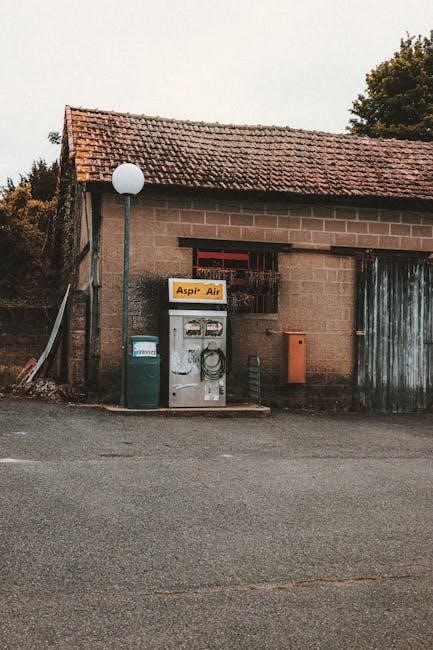
Little Giant Pump Manual: A Comprehensive Guide
This guide offers comprehensive information for Little Giant pump owners‚ including product literature‚ manuals‚ and spec sheets․ Discover everything from installation to troubleshooting to ensure optimal performance and longevity of your Little Giant pump․
Little Giant pumps have been a trusted choice for HVAC‚ plumbing‚ pool‚ and hydroponics professionals for 80 years‚ a testament to their experience and reliability; These pumps are designed for various applications‚ including removing condensate water from air conditioners‚ refrigeration equipment‚ and condensing furnaces․ They are also suitable for pumping wastewater from laundry trays‚ washing machines‚ sinks‚ or dehumidifiers‚ though not designed for raw sewage․ This manual offers instructions required to operate Little Giant pump safely․ With a wide selection of models available‚ understanding their capabilities is crucial for optimal use․

Understanding Your Little Giant Pump Model
Identifying your specific Little Giant pump model is crucial for accessing the correct documentation‚ replacement parts‚ and troubleshooting information; This section guides you through the model identification process․
Identifying Your Specific Model Number
Locating the model number on your Little Giant pump is the first step in understanding its specifications and capabilities․ The model number acts as a unique identifier‚ allowing you to access specific resources like manuals and parts lists․ Knowing this is crucial for maintenance․
This number helps differentiate between various models‚ each designed for specific applications like condensate removal or wastewater management․ Correct identification ensures you receive accurate information for your pump․ This will help optimize its life for years to come․
It also aids in ordering compatible accessories and replacement components when needed․ The model number unlocks a wealth of technical details․
Locating the Model Number on the Pump
Finding the model number on your Little Giant pump is usually a straightforward process․ Typically‚ the model number is printed on a nameplate or label affixed directly to the pump housing․ This label often contains other important information․
Look for areas such as the side‚ top‚ or base of the pump․ The nameplate might include the Little Giant logo alongside the model and serial numbers․ If the original label is damaged or missing‚ check any accompanying documentation that came with the pump at the time of purchase․ This may include the original box‚ warranty information‚ or installation guides․
Sometimes‚ the number is embossed directly into the pump casing itself․

Safety Precautions and Guidelines
Prioritize safety when handling Little Giant pumps․ Always adhere to safety guidelines and instructions to prevent injury or property damage․ Review electrical and general safety information thoroughly before operation․
General Safety Instructions
Before installing or operating your Little Giant pump‚ it is crucial to carefully read and understand all safety instructions provided in the manual․ Failure to comply with these guidelines could result in serious personal injury or property damage․ Always disconnect the power source before performing any maintenance or repairs․ Ensure the pump is used only for its intended purpose‚ as outlined in the product specifications․ Never operate the pump dry‚ as this can cause overheating and damage․ Regularly inspect the pump and its components for any signs of wear or damage‚ and replace worn parts immediately․ Keep the pump area clean and free from obstructions to ensure proper ventilation and prevent accidents․ When handling the pump‚ wear appropriate personal protective equipment‚ such as gloves and eye protection․ Finally‚ never allow children or untrained personnel to operate or maintain the pump․
Electrical Safety Information
Prioritize electrical safety when working with your Little Giant pump․ Always disconnect the pump from the power source before any inspection‚ maintenance‚ or repair․ Ensure the electrical circuit is properly grounded to prevent electric shock․ Use a ground fault circuit interrupter (GFCI) outlet for added protection‚ especially in wet or damp environments․ Verify the voltage and frequency of the power supply match the pump’s specifications․ Never use an extension cord unless absolutely necessary‚ and if so‚ use a heavy-duty cord rated for outdoor use․ Avoid operating the pump with damaged cords or plugs; replace them immediately․ Do not handle the pump or electrical connections with wet hands․ If the pump is submerged‚ ensure it is designed for submersible use and that all electrical connections are watertight․ Consult a qualified electrician for any electrical work or troubleshooting to prevent hazards and ensure compliance with local codes․
Installation Procedures
Proper installation ensures optimal performance․ Follow these procedures for safely installing your Little Giant pump‚ including wiring instructions and step-by-step guidance․ Consult the manual for model-specific details‚ which is crucial․
Step-by-Step Installation Guide
Before beginning‚ thoroughly read all safety guidelines to prevent injury or property damage․ This guide provides a simplified overview; always refer to your specific Little Giant pump model’s manual for detailed instructions․ Ensure the pump is disconnected from power․
First‚ prepare the installation site‚ ensuring it is clean and level․ Connect the appropriate fittings to the pump’s intake and discharge ports‚ ensuring a secure‚ leak-free seal․ Place the pump in its designated location‚ considering accessibility for maintenance․ Connect the discharge tubing to the desired outlet․ Finally‚ carefully review the wiring instructions before connecting the pump to a power source․ Double-check all connections before starting the pump․ After installation‚ test the pump․
Wiring Instructions
Warning: Electrical connections should only be performed by qualified personnel‚ adhering to all local and national electrical codes․ Always disconnect power before working on wiring․
Identify your pump’s voltage requirements and ensure the power source matches․ Consult the wiring diagram in your Little Giant pump manual․ Typically‚ pumps require a grounded connection․ Connect the ground wire (usually green or bare copper) to the grounding terminal․ Connect the hot (usually black) and neutral (usually white) wires to their respective terminals․ Use appropriately sized wiring and secure all connections tightly․
For pumps with a float switch‚ follow the float switch wiring diagram carefully․ After wiring‚ double-check all connections before restoring power․ Incorrect wiring can damage the pump and create a safety hazard․ Test the pump’s operation after confirming the wiring․

Operation and Maintenance
Proper operation and regular maintenance are vital for ensuring the longevity and efficiency of your Little Giant pump․ This section covers the essential procedures for starting‚ stopping‚ and maintaining your pump․
Starting and Stopping the Pump
Understanding the proper starting and stopping procedures for your Little Giant pump is crucial for its safe and efficient operation․ Before initiating the pump‚ always ensure that it is properly connected to a power source and that all safety precautions have been observed․ Refer to the specific model’s manual for any unique starting requirements․
For manual pumps‚ simply plug the unit into the appropriate electrical outlet to start․ To stop the pump‚ disconnect it from the power source․ Automatic pumps‚ often used for sump or condensate removal‚ will typically start and stop based on water level sensors․ Regularly inspect these sensors to guarantee they function correctly‚ preventing overflow or dry running‚ which can damage the pump․ Always consult the manufacturer’s instructions for detailed guidance․
Regular Maintenance Tasks
Consistent maintenance is essential for extending the life and optimizing the performance of your Little Giant pump․ Regularly inspect the pump for any signs of wear‚ corrosion‚ or damage․ Clean the pump intake screen or filter to prevent clogs‚ which can reduce water flow and strain the motor․
For pumps handling wastewater or sewage‚ periodic cleaning to remove debris is especially important․ Check the power cord and electrical connections for damage‚ and ensure they are secure․ Lubricate moving parts as recommended in the manual‚ if applicable․ If your pump has a tank‚ drain and clean it periodically to prevent sediment buildup․ Replace any worn or damaged parts promptly to avoid further issues and maintain efficient operation․ Consulting the pump’s manual ensures proper maintenance based on the specific model․
Troubleshooting Common Issues
Encountering problems with your Little Giant pump? This section provides solutions for common issues like pump failure‚ reduced flow‚ and unusual noises․ Follow these troubleshooting steps to diagnose and resolve the problem efficiently․
Pump Not Starting
If your Little Giant pump fails to start‚ several factors could be the cause․ First‚ verify that the pump is receiving power by checking the electrical connection and circuit breaker․ A tripped breaker or disconnected wire can prevent the pump from operating․ Next‚ inspect the pump for any visible obstructions or debris that may be hindering its movement․
Examine the impeller to ensure it is free to rotate․ If the impeller is clogged‚ carefully remove any obstructions․ Additionally‚ check the float switch (if applicable) to ensure it is functioning correctly and not stuck in the off position․ A faulty float switch can prevent the pump from activating․ If the pump still does not start after these checks‚ consult a qualified technician for further assistance․ Remember safety first!
Reduced Water Flow
Experiencing reduced water flow from your Little Giant pump? Several issues could be responsible․ Begin by inspecting the pump’s intake for any blockages․ Debris such as leaves‚ sediment‚ or other foreign objects can restrict water flow into the pump․ Clean the intake screen or filter thoroughly to ensure a clear passage for water․
Next‚ examine the discharge hose or pipe for kinks‚ bends‚ or obstructions․ These can significantly impede water flow․ Straighten any kinks and remove any blockages to restore optimal flow․ Additionally‚ check the impeller for wear or damage․ A worn or damaged impeller can reduce the pump’s efficiency․ Replace the impeller if necessary; Finally‚ ensure that the water level is sufficient for the pump to operate effectively․ Low water levels can cause the pump to draw air‚ resulting in reduced flow․
Parts and Accessories
Find information on identifying and ordering replacement parts for your Little Giant pump․ Explore available accessories to optimize its performance and extend its lifespan․ Get the parts you need!
Identifying Replacement Parts
To ensure optimal performance and longevity of your Little Giant pump‚ it’s crucial to use the correct replacement parts․ This section will guide you through the process of identifying the specific components needed for your particular pump model․ Begin by locating the model number on your pump‚ as this is essential for accurate part identification․ Consult the parts diagram or exploded view in your pump’s manual to visually match the part you need to replace․ Pay close attention to the part’s shape‚ size‚ and any identifying markings․ Cross-reference this information with the parts list provided in the manual or on the manufacturer’s website․ If you’re unsure‚ contact a Little Giant authorized dealer or service center for assistance in identifying the correct replacement part․ Using genuine Little Giant parts guarantees compatibility and helps maintain the pump’s efficiency and reliability․
Ordering Information
Once you have identified the correct replacement parts for your Little Giant pump‚ you’ll need to know how to order them․ You can purchase genuine Little Giant replacement parts through several channels․ Authorized Little Giant dealers and service centers are excellent resources for obtaining parts and receiving expert assistance․ To locate a dealer near you‚ visit the Little Giant website or contact their customer service department․ When ordering‚ be sure to have your pump’s model number and the part numbers of the required components readily available․ You can also order parts online from reputable retailers specializing in pump supplies․ Before placing an order‚ verify the retailer’s return policy and ensure they are an authorized distributor of Little Giant products․ When you are ready to make your purchase‚ remember to compare prices from different sources to get the best deal․ Always use genuine Little Giant parts․

Warranty Information
Understanding your Little Giant pump’s warranty is crucial․ Review details regarding coverage periods‚ limitations‚ and exclusions․ Keep your purchase documentation handy․ Contact customer support or visit the official website for clarification․
Warranty Coverage Details
Little Giant pump warranties vary depending on the specific model and its intended use․ Typically‚ warranties cover manufacturing defects in materials and workmanship under normal operating conditions․ Be sure to register your pump to validate warranty coverage․ The warranty period usually starts from the date of purchase․ It’s crucial to retain the purchase receipt as proof of the purchase date․ Damage caused by improper installation‚ misuse‚ or neglect is generally not covered․ Regular maintenance‚ as outlined in the manual‚ is often a requirement for maintaining warranty validity․ Certain components‚ like seals and impellers‚ may have limited warranty periods․ Consult your pump’s manual for precise details regarding warranty coverage and exclusions applicable to your model․
Making a Warranty Claim
To initiate a warranty claim for your Little Giant pump‚ first‚ gather all necessary documentation․ This includes your proof of purchase‚ the pump’s model and serial number‚ and a detailed description of the issue you’re experiencing․ Contact Little Giant’s customer service department or an authorized service center to begin the process․ Be prepared to provide the information you’ve collected and follow their specific instructions․ You may need to ship the pump to a designated repair facility for inspection․ Ensure the pump is properly packaged to prevent damage during transit․ If the issue is covered under warranty‚ the pump will be repaired or replaced at Little Giant’s discretion․ You will be notified of the outcome after inspection․